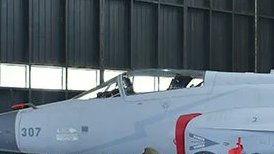Meet Pakistan’s JF-17 Thunder: A Pitiful ‘Successor’ To The F-16
By
Christian Orr
5 days ago
U.S.-Pakistani relations have long had a bipolar disorder-like history. On the positive side of the ledger, America had a substantive relationship in the 1980s with then-strongman
Gen. Zia-ul-Haq as the two countries cooperated to support the Afghanistan
mujahideen rebels’ resistance campaign against the Soviet occupation; this was a major boost to the Ronald Reagan Administration’s policy of
rollback of the Soviet Union. In addition, in the early days of the Global War On Terror, then-POTUS George W. Bush had a productive relationship with then-Pakistani President
Pervez Musharraf. On the negative side of the ledger, Pakistan’s security apparatus, particularly their infamous
Inter-Services Intelligence (ISI) agency, has long been supportive of the Taliban. Even more irksome for the U.S, given the current state of global affairs, has been Pakistan’s cozy relationship with America’s
biggest global adversary, Red China. That buddy-buddy Sino-Pakistani relationship is embodied in the JF-17 fighter jet program.
An Unholy Alliance?
The CAC/PAC JF-17 Thunder (Urdu: جے ایف-17 گرج) AKA the Xiaolong (枭龙; “Fierce Dragon”) is a joint venture by the PRC’s Chengdu Aircraft Corporation – the same company that produces the
J-20 Wēilóng(“Mighty Dragon”) fighter – and the
Pakistan Aeronautical Complex (PAC). It is a lightweight, single-engine, multi-role combat aircraft, intended to replace the ageing A-5C, F-7P/PG, Mirage III, and Mirage V combat aircraft in the Pakistan Air Force (PAF) arsenal, though the “-17” denoting that, in the PAF’s viewpoint, it is the successor to the
F-16 Fighting Falcon – sales of the F-16 to Islamabad have been yet another
ongoing bone of contention in U.S.-Pakistani relations.
The Thunder made its maiden flight on 25 August 2003 and was officially introduced into PAF service on 12 March 2007. Additional users are the
Nigerian Air Forceand Myanmar Air Force, and reportedly the Iraqi Air Force (IqAF) has set aside
over $600 million USD (875.9 billion Iraqi dinars) to purchase 12 of the jets to supplement its fleet of F-16s and
Czech-made Aero L-159ALCA light combat aircraft. 164 airframes have been built thus far.
Yet another potential foreign customer
is Argentina, which would put PAC in direct competition with south Asian subcontinental archrival India and that country’s homegrown
HAL Tejas lightweight fighter aircraft. A June 2022 article by Usman Ansari and Jose Higuera in
DefenseNews reported a visit to Pakistan by Gen. Juan Martín Paleo, the head of Argentina’s joint military staff that in turn fed speculation that a JF-17 fighter jet deal was potentially on the horizon. The reporters added that in May, “a delegation of [Argentine] Air Force pilots and technicians evaluated the JF-17 in China. This included a full technical evaluation, use of a simulator and evaluation flights. In the more recent trip to Pakistan, officials discussed collaboration on defense materiel production during a visit to the Ministry of Defence Production.”
Specifications
PAC’s
official info page on the JF-17 lists the warbird as having a fuselage length of 47 feet, a height of 15 feet, a wingspan of 31 feet, an empty weight of 7,965 kg (17,559 lbs.) and a maximum takeoff weight of 13,500 kg (29,762 lbs.). Max airspeed is 1.6 Mach (1,190 mph/1,910 kph/1,030 knots) with an Indicated Airspeed (IAS; presumably a synonym for cruising speed?) of 700 knots. Service ceiling is 55,500 feet, ferry range is listed at 1,880 nautical miles. Armament-wise, there are 8 hardpoints capable of carrying a variety of air-to-air missiles, air-to-surface missiles, or 3,400 kg (7,495 lbs.) worth of bombs; gun-wise, the official company literature only makes a generalized reference to a “23 mm double barrel gun,” whilst the
Quwa Defence Newswebsite specifies it as a
GSh-23-2.
As to whether the Fierce Dragon has actually lived up to its moniker in combat, conflicting stories abound. On the one hand, official PAF sources claim that JF-17s took part in Pakistan’s retaliatory 2019 Jammu and Kashmir airstrikes, in which Pakistan shot down an
Indian MiG-21. On the other hand, Indian news agencies such Defence Aviation Post, in an apparent effort to one-up their Pakistani nemeses,
tell a different story:
“Indian aircraft intercepted the Pakistani attack, and Wing Commander Abhinandan Varthaman shot down an F-16 that was much superior before crashing his vintage MiG-21 Bison in Pakistan-occupied Kashmir (PoK). The much-heralded Sino-Pak produced JF-17
was only there for show, did not see the air action, and remained hidden behind the American fighters as the US F-16 fired air-to-air missiles at Indian fighters. Due to a shortage of replacement parts for the Klimov RD 93 aircraft engine, which is built in Russia, the JF-17 programme is currently in a rut.” (emphasis added)
Unintended Consequences: Trouble In Pakistani Paradise
Speaking of “in a rut,” The Law of Unintended Consequences appears to be coming into play to the JF-17’s detriment. In essence, the
sanctions placed upon Russiaon account of their “special military operation” in Ukraine have led to a lack of spare parts for the Russian-made Klimov RD 93 aircraft engine, which has reportedly caused the PAF’s JF-17 fleet
to be grounded. As Shishir Gupta of
The Hindustan Times reported last month,
“Stung by multiple failures of JF-17 aircraft, primarily due to the serviceability of RD-93 engines, Pakistan had directly approached Russia for procuring the RD-93 engines, bypassing China. In the aftermath of multiple negotiations by Islamabad with Moscow, Russian engine company Kilmov has now indicated its willingness to supply RD-93 engines and its associated repair systems and maintenance facilities to JF-17 aircraft…However, in 2018, M/s Rosoboronexport, which is authorised to export defence equipment including RD- 93 engines and spares, was sanctioned by the US, thereby adversely affecting the sourcing of RD-93 engine spares by the PAF. The sanctions restrict Rosoboronexport from undertaking US dollar transactions, which the two governments and the concerned banks have now been attempting to sort out.”
If, when, and how these issues will be sorted out is anybody’s guess.
Christian D. Orr is a former Air Force Security Forces officer, Federal law enforcement officer, and private military contractor (with assignments worked in Iraq, the United Arab Emirates, Kosovo, Japan, Germany, and the Pentagon). Chris holds a B.A. in International Relations from the University of Southern California (USC) and an M.A. in Intelligence Studies (concentration in Terrorism Studies) from American Military University (AMU). He has also been published in The Daily Torch and
The Journal of Intelligence and Cyber Security. Last but not least, he is a Companion of the Order of the
Naval Order of the United States (NOUS). In his spare time, he enjoys shooting, dining out, cigars, Irish and British pubs, travel, USC Trojans college football, and Washington DC professional sports.





